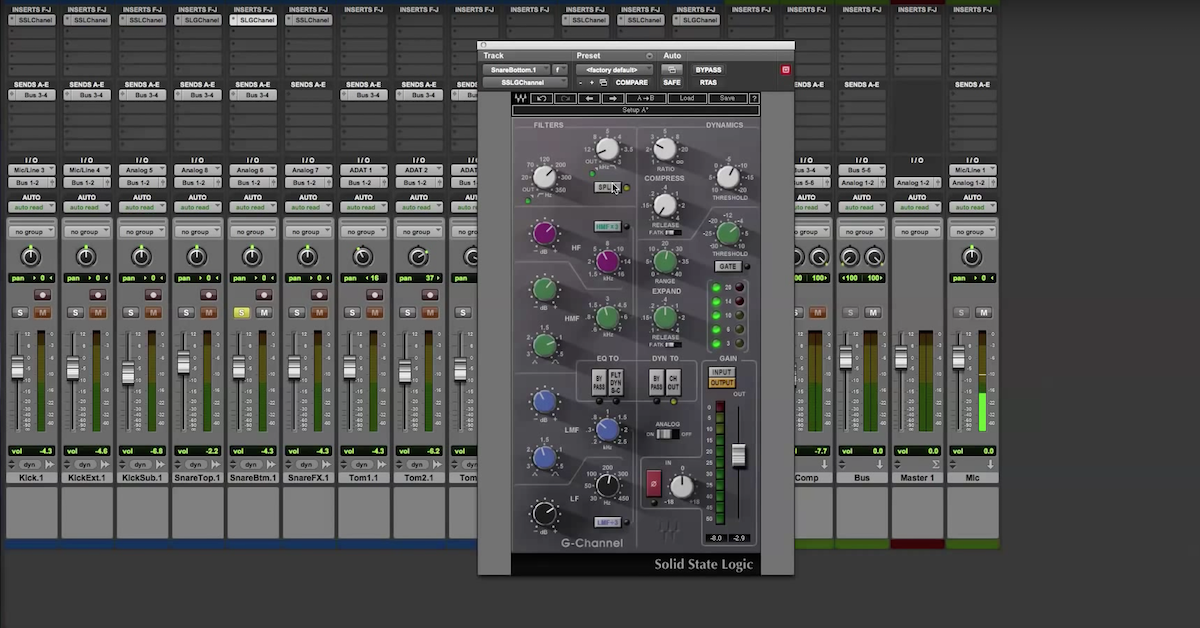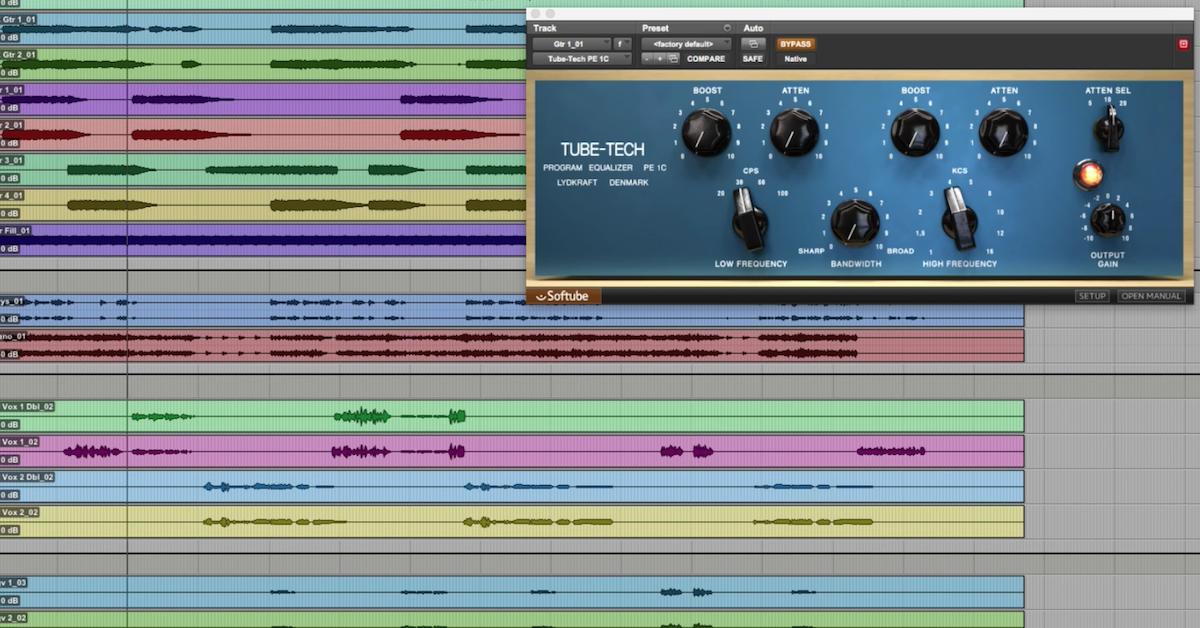Eric Tarr’s Top 10 Favorite Plugins
Article Content
I was inspired by David and Ian’s lists of favorite plugins. I think each plugin they selected is well deserving of a spot. It is hard for me to imagine completing a session without making use of most of the plugins they recommend.
With that being said, here is my list of favorite plugins:
1. Softube Tube-Tech Classic Channel
It’s hard to argue with a plugin from Softube that models a CL-1B compressor and a “Pultec-style” equalizer by Tube-Tech. It might take some time and practice to get used to the controls but after you do, it can be fun, intuitive, and inspiring.
The interaction of the individual bands of EQ make for a very musical processing experience. Although this plugin doesn’t give you a lot of visual feedback from the GUI (like an EQ curve), it can perform almost any EQ task during a mixing session.
The CL-1B compressor is flexible enough to be used on everything and sounds good enough to take on the responsibility of processing the most important aspects of your mix.
2. Slate Digital VTM
VTM is equally deserving of the praise commonly given to Slate Digital’s VCC and VBC. Besides, the engineering task of properly modeling analog tape with a digital algorithm is arguably even more complex than that of an analog console or compressor.
In my opinion, the thing that makes VTM valuable is that it aims for realism and achieves it, rather than an artificial ‘hyped’ sound like many other competing ‘tape sim’ plugins.
On top of that, it’s useful on every single individual track, sub-mix, and master group in your session. How many other single plugins can you say that about?
You can use it for ‘spectral’ processing to enhance your low-end and tame your high-end. You can use it for ‘dynamics’ processing to smooth transients and glue together a mix. You can use it for ‘saturation/distortion’ processing without ever sounding harsh. Some people even claim you can use it for ‘spatial’ processing to open up a mix, add depth, widen the stereo field, and separate elements in a natural way.
To me, these are just attempts to describe the indescribable “magic” that can only be achieved through putting an audio signal on tape (even if it is virtually).
3. Sonnox Oxford Inflator
The Inflator is a plugin that can make everything it processes sound better. It is a type of harmonic exciter, with an advantage that it cannot be pushed to the point of sounding harsh or distorted (like many other exciters). But, that doesn’t mean you should give in to the temptation to put it on everything and max it out.
What gives this plugin its value, is not that is simply makes things sound better, but rather it gives you control over the elusive perception of ‘depth’ on a signal.
Conventionally, adding reverberation to signal can make it sound distant or further away. The Inflator adds the perceptual opposite, making a signal sound close. It does this by emphasizing higher harmonics in the signal. Our ears perceive signals with loud harmonics as being close. Therefore, with this plugin you can control depth, without washing out your mix with reverb.
4. Native Instruments RC-48 / RC-24
These two plugins are modeled after famous Lexicon reverb units. RC-48 and RC-24 are the simplest models of the Lexicons that I have come across. In a matter of seconds, it is easy to dial in reverb type, reverb time, and modulation to accomplish everything from a short room to a cavernous hall.
Sometimes a song calls for an artificial reverb rather something that sounds like a realistic acoustic space (see recommended convolution plugins from Matt and David). These plugins fit the bill.
5. Celemony Melodyne
As much as most every musician and engineer scoffs at one point and time about using “pitch correction,” it can be a necessary evil. Sure it takes a bit away from the ‘natural performance,’ and it helps plenty of talentless people ‘make it’ in the music industry. But it also helps a lot of talented people make a good performance great.
Here is my perspective: I would rather record an emotional, out-of-tune performance than a perfectly in-tune, emotionless performance. Many times the constraints of a recording session don’t allow for the endless amount of time to get the best of both worlds. Until someone invents an “add emotion to a boring performance” plugin, I will be using Melodyne to fix the tuning problems of sincere performances.
Bottom line: every serious engineer needs to have a pitch correction plugin at their disposal and also know when to use it.
6. Softube FET Compressor
When it comes to 1176 plugins, there are a lot to choose from. Waves CLA-76 has been the standard for a long time, and for many good reasons. I have used on every session I have mixed for years.
However, the Softube FET compressor is my personal preference whenever I am specifically going for the 1176 sound with extreme gain reduction. It definitely has a unique sound when you push it, and I prefer what it does for crushing drums, guitars, and parallel compressing vocals.
Better yet, it has a “wet/dry” mix knob (unlike CLA-76) to dial in parallel compression from within the plugin.
7. Waves RBass
This plugin is a harmonic exciter for low frequencies. It is an essential plugin to have for two reasons:
- It is inevitable if you work in music for any length of time that you will come across a song that sounds weak in the low end. Simply boosting the low end with an EQ may not work. RBass can do things that EQ cannot.
- A lot of consumers listen to music on speakers that cannot reproduce low frequencies (<100 Hz). RBass can be used subtly to trick people into thinking they hear bass that actually isn’t there.
Note: RBass uses a similar algorithm to other Waves plugins like MaxxBass. My preference for RBass is strictly because it is the easiest to operate.
8. SoundToys Devil-Loc Deluxe
This plugin can be very extreme, so it may not be for every session. Unless, of course, every session you do involves huge, larger-than-life, over-the-top, rock-your-face-off drums. In that case, this plugin is a no-brainer.
For the rest of us, you will be glad you have it in the rare circumstance that you need it. Nothing beats the look on your client’s face when you pull up this plugin and it is just what they want. Honorable mention: Softube Valley People Dyna-mite.
9. Line 6 Pod Farm 2
Originally marketed as an “amp simulator” plugin, but the modeling used for the amplifiers is a generation or two out-dated (and is in need of a real upgrade). To me, its value is in the delay and modulation effects. They are simple, versatile, and cover the entire range of effects.
I prefer these far and above the comparable stock plugins in my DAW. It would be icing on the cake if Line 6 ever got a round to releasing upgraded models of all these effects.
10. Softube Saturation Knob
To begin with — it is free. Even if you own VCC, NLS, Decapitator, etc., this plugin saturates differently. It is simple, and hardly wastes any CPU processing. When you need it, pull it up, let it do its thing, and move on to something else.






